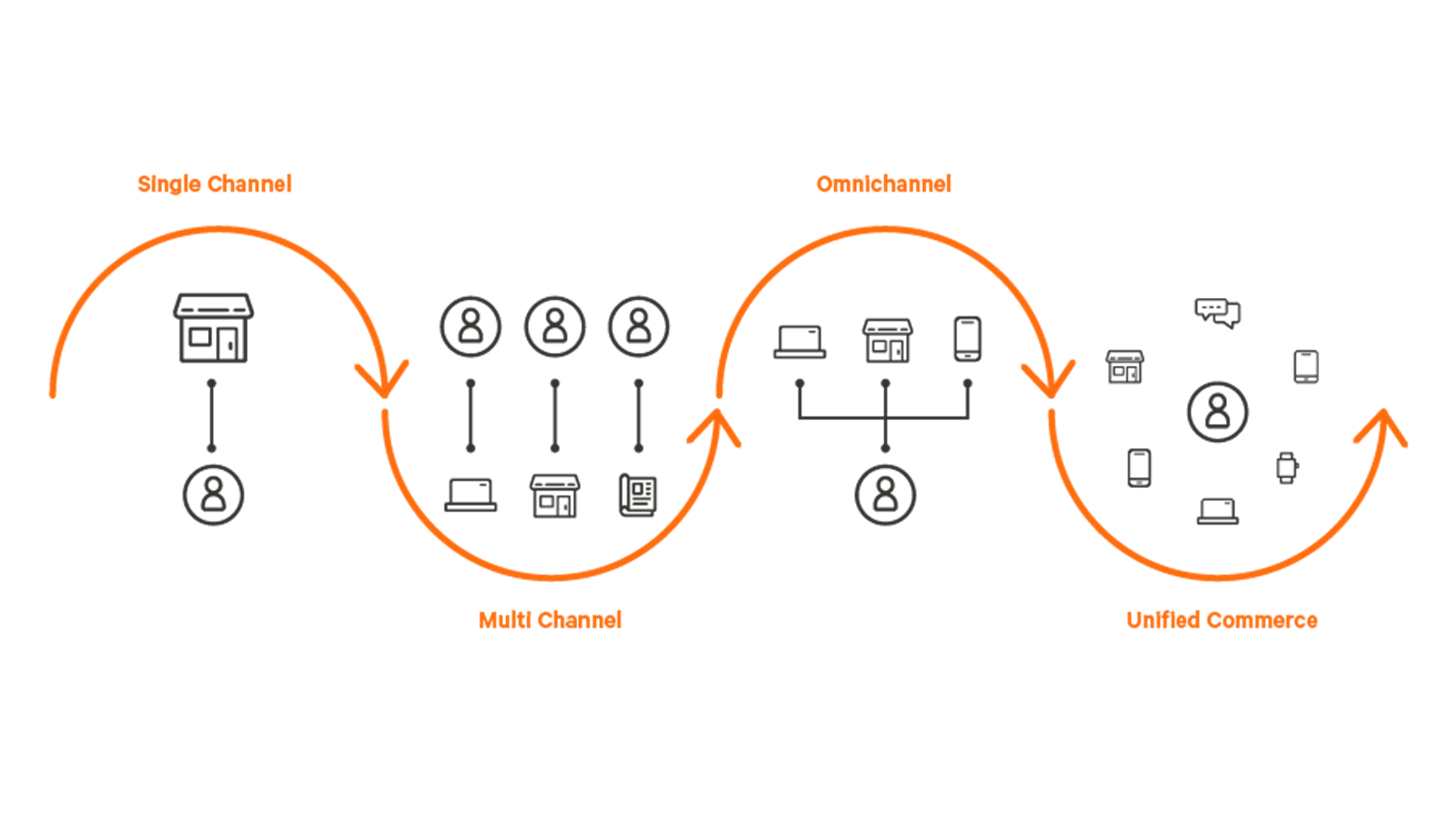Unified commerce is a single platform that allows you to connect your backend systems with your frontend channels seamlessly. It offers a single view of your inventory, your sales channels, and insights into the customer journey. According to research by BusinessWire, more than 86% of spending on retail software is focused on the unified commerce concept, meaning this trend is becoming crucial for retailers. While you may know about omnichannel, unified commerce is the next step for your retail extensibility and scalability. Let’s explore the unified commerce definition, its benefits, components, and what you should expect in a best-fit unified commerce solution.
What is unified commerce?

Unified commerce is the medium that connects all the dots from POS, order fulfillment, product and inventory management, sales channels, customer management, etc. to consolidate data to automate your business and support omnichannel journeys for customers. In unified commerce, your online and offline stores are supported by a single platform that serves customers seamlessly regardless of where they start and end their shopping journey.
Via one centralized platform, unified commerce captures a complete view of your business, tracks your performance and KPIs across channels, and provides a collaborative environment for your teams. All sales, marketing, procurement, finance, and HR departments can access relevant data and sync their data to the central hub of unified commerce, preventing discrepancies and errors. With a single source of truth, you can make more informed business decisions, and better prepare for future change.
Compare different types of commerce: multichannel, omnichannel, unified commerce

Multichannel vs. Omnichannel vs. Unified commerce
Multichannel retailers operate in various channels, such as brick-and-mortar stores, websites, social media, marketplaces, etc. Customers can engage and shop on their preferred channel, however, the channels are fragmented with little integration. This means you cannot track which touchpoint and which products the customers are interested in, which may result in a missed opportunity to serve customers better.
Omnichannel retail is a more connected method that links channels and offers a smooth customer experience among them. Channels can talk to each other, but they require many integrations in the backend to do so. Information on products, images, pricing, inventory, etc. can be edited in 1 channel and needs duplicating in others. However, if data is entered differently in 2 channels, it will cause inconsistency of data and cost you time to figure out the problem.
The next evolution of omnichannel commerce is unified commerce.
Although many people mistake omnichannel vs unified commerce, unified commerce inherits the power of omnichannel customer experience, but with an advanced upgrade in the backend for operation. It harmonizes all channels, payment systems, products, and customer data to deliver a customer-centric retail experience, touching everything from the purchase journey, fulfillment, customer service, returns, and refunds, etc. In the backend, retailers can enjoy a simplified ecosystem that is managed in a single platform, thus you can monitor your performance and deliver a consistent brand experience for customers.
In fact, an omnichannel POS like Magestore point of sale is already as powerful as a unified commerce platform. With Magestore POS, you can sync all sales and inventory data in real time, sell across channels, and manage operations like purchasing, inventory, orders, and customer service from a single dashboard.
Benefits of unified commerce

When you apply unified commerce retail, here’re the benefits you can achieve:
Real-time stock management
Offering real-time order and inventory visibility is essential for customers to navigate shopping options and order fulfillment. Providing accurate data on stock or generating a low-stock alert will provoke a sense of urgency to complete the order.
In addition, with real-time inventory ability, you can get a holistic overview of your processes, from purchasing to sales, to distribution, to pricing and warehouse management. For example, you can see when and which channel an item is purchased, and the updated inventory quantity accordingly. If a product is running low on stock, you’ll receive an alert from the system. You can then quickly create a purchase order (PO), ensuring on-time product replenishment to meet customers’ demands.
Data consistency
When you have 1 platform to operate the entire company, all departments can access and work on the same data. A centralized database that stores information in a consistent form provides you with a single version of the truth for your company. Once you have reliable figures on hand, all processes become easier, from financial reporting to KPIs tracking and product information. You can monitor the performance of each department, identify bottlenecks and make data-driven decisions that will benefit your business.
Less human error, more automation
With a unified commerce infrastructure, many tasks can be automated, reducing manual work and human errors. You improve your operational efficiency and save human resources for more important jobs by:
- Processing payments and refunds via one platform regardless of channels and regions;
- Creating automatic PO and contract for multiple vendors and managing product SKUs accordingly;
- Syncing data on sales and stock to ensure consistency without manual data entry;
- Gathering all data for report and analysis, reducing the workload of your reporting and finance teams.
Seamless personalized shopping experience
One of the prominent goals of unified commerce is to boost personalized shopping experiences and suggest the right product that meets customers’ demands. Unifying customer data is the key to getting a 360-degree view of your customers and understanding their preferences across channels. For example, if you know have a customer segment favoring a specific type of product and where they like to shop, you can push a suitable loyalty program to provoke sales for this group.
If you can dynamically display the most relevant products and content for customers based on their location and purchase history, your customers can connect with the right products faster and keep coming back. The ability to integrate personalization into the omnichannel approach is the power of unified commerce. This way helps increase customer satisfaction, and your sales revenue will rise as a result.
Reducing time spent on integrations
Unlike the omnichannel approach where you must integrate various systems, one to handle suppliers, another one to manage sales, and the third one for an eCommerce site, you’ll need extra effort to set up and maintain real-time synchronization among these software. If you need an upgrade or change to a new system, you’ll have to ensure the new system is compatible with others, not to mention the burden of migrating data to the new place. All these tasks are complex and expensive.
Therefore, a unified commerce platform can solve all these problems. Since most of the functionalities you need are already included in 1 platform, you can limit integrations, saving time and cost for your actual business activities.
Components of unified commerce

There are 4 major components of unified commerce to help you achieve greater agility and scalability:
1. Systems
Unified commerce is a centralized platform for all backend systems and customer-facing channels to work cohesively with one another. Whether it’s a POS solution, an inventory management system, or an omnichannel eCommerce platform, each is an important function for the whole business. Having your company built on 1 solid foundation allows you to easily adapt and scale your business needs. With unified commerce, you can expand to new channels, enter new markets, and embrace emerging technologies like mobile wallets or endless aisles without complicated configurations for multiple software.
2. Channels
Customers expect a joyful and seamless shopping experience. If a customer switches to another channel within your company, the experience must remain smooth and easy to navigate. By unifying customer identity across channels, you can offer a consistent experience regardless of where they touch your brand. For example, a customer should be able to see your promotion on your website, mobile app, or in-store, and can fulfill cross-channel purchases such as O2O, endless aisle or click-and-collect options, or the ability to buy online and return offline. You can also measure your results: check how opening a store affects your eCommerce sales in the same area, or how a loyalty program affects your in-store purchases.
3. Products
Product information must be consistent and up to date across channels to deliver accurate information to customers and also your sales team. All information including the product description, the available on-stock quantity, discount policy, etc. must be the same in all sales channels and inventory management interface. Unified commerce let customers know product availability, and they can track the delivery status.
4. Interactions
Since your customers are interacting with a set of omnichannel distribution of your business, you should record their behaviors in a unified way across each. Customer interactions are valuable data that you should analyze deeply to discover insights and understand your customers. Centralizing customer data will help you recognize shoppers across multiple touch points and make a personalized experience for them. For example, a customer won’t need to input their payment details every time making a purchase and can check out with one click from whichever channel they want.
What makes a best-fit unified commerce solution

If you want to apply unified commerce retail, here’re the criteria of the best-fit unified commerce solution:
Consolidate and synchronize all POS data in real time
The foremost requirement of unified commerce is the ability to sync data across systems and channels in real time and generate relevant reports for your business decisions. There’re 3 main aspects of data you should keep track of, including:
- Product data: Make sure product attributes, stock level, and prices are consistent between the POS, inventory management app, and all customer-facing stores. Getting accurate data on inventory is crucial, so you can manage your sales volume, and get ready for stock refilling, while customers can know instantly if a product is available. For all the data to be consistent in the most efficient way, you can choose a POS that is native to the eCommerce platform you are using. For example, a Magento 2 point of sale will automatically sync all the data with Magento without any external middleware or connectors.
- Sales order data: Whenever a customer makes a purchase, the sales data is recorded automatically and centralized in 1 backend. You can measure your sales performance, find out your bestsellers and the most profitable channel, or any patterns that affect your sales. Establishing your key metrics and monitoring them closely to get a clear picture of your business efficiency.
- Customer data: All data about your customers are collected to a central hub for analysis. This includes their demographics, behaviors, interactions, and preferences. Knowing your customers is the best way to create a personalized and consistent omnichannel experience for them.
Sell everywhere from one platform
Keep all your stores up-to-date
No matter how many stores you have and what channels you sell on, data is updated immediately across your stores. The unified commerce platform will update inventory, send you low-stock alerts, and support inventory count and transfer so that you can avoid out-of-stock and overstock situations.
Serve customers at their choice of touchpoint
You can be present and ready to sell on any channels your customers favor, such as your website, mobile app, marketplaces, social media, or physical shops. The data is shared among channels, ensuring a consistent experience for your customers and converting more sales.
Bring more customers to your business and boost revenues
Create an outstanding shopping experience
With centralized customer data, you can access their information, and purchase history, and recommend what they may like to increase the upsell and cross-sell opportunities.
Besides, there’re many shopping options that customers would love: click and collect; buy online, ship to store; endless aisle experience; online to offline, and flexible returns. You can consider adopting suitable approaches for your business.
Retain customers with online-offline loyalty programs
You can delight existing customers by applying store credits, reward points, and gift cards to keep them loyal. Customers should be able to earn and spend these points in any channel they want. This way boosts your customer engagement, retention, and your customer base.
Checkout anytime even in offline mode
In unified commerce, payment processing must be smooth in any channel, any device, regardless of online or offline mode. The shopping experience must not be disrupted due to Internet disconnection, which can cause you to lose orders. A good platform ensures no hassles in operation even if the Internet goes down.
Even though these are the features of unified commerce, Magestore omnichannel POS has already accomplished the same things. Learn more about our omnichannel strategy if you’re interested.
FAQs
What is a unified commerce platform?
By definition, a unified commerce platform is a central platform that consolidates backend commerce solutions to create a fully unified data model of a single source of transactional truth. This platform removes technological barriers, and syncs all data flowing on sales, products, and customers in real-time, helping you to control your entire business easily and create a unified shopping experience for customers.
What is a unified shopping experience?
Since customer journey is now more complex than ever, your brand must prepare to serve them on any channels they’re on. A unified shopping experience ensures a customer is recognized and provided with consistent information on any channel. For example, a customer can see a promotion on Instagram that leads them to your website to place an order, and then he/she can choose to pick up the product at your physical store.
What is a unified shopping cart?
A unified shopping cart is the cart checkout process that allows customers to add, remove, modify or purchase any items in their digital cart across available touchpoints and devices. No matter whether the customers are in-store, online, or on the retail app, they can see their current cart and checkout anytime. Creating a cohesive checkout experience is vital to bringing your retail to the next level and reaping the benefits.













